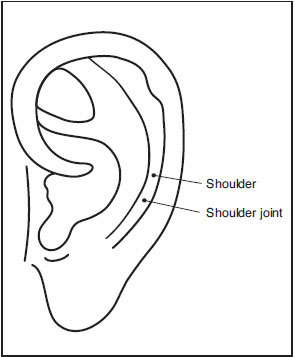Shoulder pain is a common problem. In terms of its success rate with acupuncture, it is one of the easier musculoskeletal disorders to treat. This chapter presents four treatment options that I commonly choose from, all which are effective and easy to execute. The practitioner is encouraged to review and select those that he/she prefers and that can best help the patient.
First, regardless of the treatment selected, have the patient explain the etiology of the problem, its duration, intensity, what makes it better or worse, and other relevant characteristics. Determine the range of motion the patient has by having them move their arm and shoulder in all the normal movements (rotation [lateral and medial], abduction, adduction, flexion, and extension), and evaluate the type of impaired mobility they have.
 Auricular Acupuncture
Auricular Acupuncture
Personally, I typically choose ear massage and treatment as my first and most successful therapeutic modality because of my affinity for auricular medicine and its proven effectiveness.
In the ear, locate the shoulder point if the problem is musculoskeletal or the shoulder joint point if the problem is confined to the joint. Vigorously rub the chosen ear point between your thumb and index finger. Do this with the patient seated or standing. Let the patient know they will feel a very strong sensation elicited by the rubbing. Perform this step for 15 to 30 seconds. The stimulus will be very intense and the patient may grimace or tell you it is painful. After this time span, have the patient make the shoulder movements that were performed earlier. In most cases, if your ear point location was accurate, you achieved the desired stimulus (i. e., strong sensation and/or heat), and the patient can tolerate it, there will be 50–100 % improvement in the shoulder. If this technique has been effective, but you feel the shoulder needs further reinforcement, you can affix a Magrain pellet or an ear seed to the point so that the patient can retain it for about three days. Instruct them to rub it gently three to five times a day for about 3 to 5 seconds and at the same time to mobilize the affected shoulder.
If their shoulder problem is along the large intestine channel, select the shoulder point on the contralateral (opposite) side of the patient’s shoulder pain. The reason for treating the opposite side is that the large intestine’s divergent channel exits at LI-15 (jian yu) and so the point on the opposite side will treat the shoulder pain. If the pain is more posterior, i. e., along the scalene muscles or in the Gall Bladder 21 (jian jing) area, select the ear point on the same side as the patient’s shoulder problem. See Figure 15.1 for the location of these points.

Stay updated, free articles. Join our Telegram channel

Full access? Get Clinical Tree





